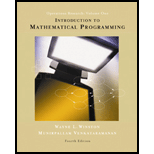
Explanation of Solution
Formulation of LP:
Let,
The profit per 100 litter on chemical B is $12.
for
Also, the profit on
The total selling price
The cost per 100 litter on chemical A is $6.
If the user purchases
For processing
Subtracting the purchasing cost and processing cost from selling price, the actual profit is found.
Therefore, the objective function is,
Maximize,
Constraint 1:
For, 100 litters of A, 3 hours of labour is needed
For
Similarly, for 100 litters of C, 1 hour of labour is needed
For,
Therefore, total labour time required is
Since, only 200 labour hours are available, the constraint is
Want to see the full answer?
Check out a sample textbook solution
Chapter 3 Solutions
Introduction to mathematical programming
 Operations Research : Applications and AlgorithmsComputer ScienceISBN:9780534380588Author:Wayne L. WinstonPublisher:Brooks Cole
Operations Research : Applications and AlgorithmsComputer ScienceISBN:9780534380588Author:Wayne L. WinstonPublisher:Brooks Cole
